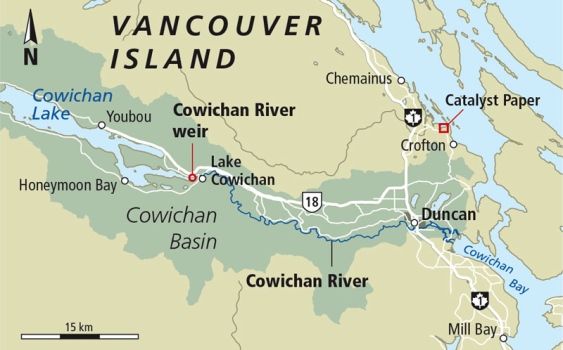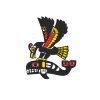Amy Smart, Times Colonist, July 12 2015
 Pressure is rising on the Cowichan River, as drought conditions force its stewards to balance conflicting needs — from the livelihood of mill workers to the lives of salmon.
Pressure is rising on the Cowichan River, as drought conditions force its stewards to balance conflicting needs — from the livelihood of mill workers to the lives of salmon.
Much of the region is already under water restrictions after a warm and dry winter and spring, with homeowners unable to water lawns, fill pools or wash cars.
The source of the river is Cowichan Lake; its flow is controlled through a weir owned by Catalyst Paper. The lake’s water level on July 9 was about half what it is in a typical year, and unless it is significantly replenished by rainfall, the flow is projected to begin disappearing on Sept. 16.
If that happens, operations at Catalyst Paper’s Crofton mill, which employs about 600 people, could be affected.
The company is trying to buy more time in the fall — 15 days, to be exact — by reducing the river’s flow now, essentially making what water there is last longer.
Catalyst has already reduced the flow from the usual minimum of 7.0 cubic metres per second to 5.5, with permission from the province.
Two weeks ago, it requested a further reduction to 4.5 cubic metres per second — about as low as the mill can function on. The company has successfully reduced flow to 4.5 cubic metres per second in previous years, including two months last summer.
But this year, the request has been stalled by stakeholders concerned about salmon stocks. “Any reduction in flow from what it currently is will further cause stress on those fish and potentially mortality,” said Andrew Thomson, south coast area director for Fisheries and Oceans Canada.
Most southern Vancouver Island rivers are already under a fishing ban because of the drought. Low river levels can strand fish in pools, cutting them off from the main stream and making it so they can’t make it upstream to spawn. The shallower water can also become too warm, causing stress to fish and making them more vulnerable to diseases.
The DFO has detected about 40 fish in the lower river, indicating a spring run, but they haven’t made their way to Cowichan Lake yet, Thomson said. “Knowing those fish are in the system, we’re quite concerned,” he said.
The department is planning to conduct a stream survey with the Cowichan Tribes this week. They will be looking to determine whether the salmon are in safe spots, before supporting the flow reduction.
Cowichan Tribes Chief William Seymour couldn’t be reached for comment.
Thomson has visited streams and rivers across the Island and said the Cowichan River chinook is not unique in its vulnerability.
“I’ve gone up Vancouver Island and this is pretty much unprecedented, in my memory,” he said.
“We have some very extreme water-flow conditions in a lot of our rivers.”
The water levels also affect other river users. North Cowichan maintains the Joint Utility Board’s wastewater treatment plant, which serves about 30,000 people. Treated sewage is discharged into the river, where the water dilutes the waste to levels considered safe.
The dilution still falls within the safe range, but it’s at the low end of what’s ideal, said John MacKay, North Cowichan’s director of engineering and operations. Further flow reductions could change that.
“It provides a safety factor,” MacKay said.
The municipality has already used plastic tubing to extend the outfall to a deeper part of the river. In the long term, the municipality is planning to move the outfalls altogether, as part of its lease agreement with the Cowichan Tribes.
“With the lower river flows, we’re doing additional monitoring,” MacKay said. “We went through this process last summer as well, so we’re kind of prepared for it.”
Recreational tubing is also safer with a stronger river flow.
“When it gets too low, it changes the dynamics, so it can create some safety risks,” said Jacob Ellis, senior policy analyst at the Cowichan Valley Regional District.
Unlike fishing, there are no bans on recreational tubing, he said.
Ultimately, the Ministry of Forests, Lands and Natural Resource Operations has the final say on water-flow reduction. The province has approved the reduction to 4.5 cubic metres per second “if required,” a ministry official said.
But the ministry depends on information and recommendations from the Cowichan Watershed Board’s flows and fish working group. The stakeholder group meets weekly and will consider the upcoming salmon survey before submitting its approval.
Regardless of the outcome, a mill shutdown is not part of the plan, said Rob Belanger, vice-president and general manager of the company’s Crofton division, adding the company has never stopped operations for lack of water in its 57 years. Catalyst has already reached its goal of reducing water use by 10 per cent since last year and is using saltwater in place of freshwater, where possible, he said.
“If we carefully monitor the flow, we believe we’ll be able to service our customers through the summer,” Belanger said.
“There’s a lot of contingencies and water-reduction strategies we would do before we got to any decision like [shutting down the mill].”
© Copyright Times Colonist
 Email
Email



